My favourite little Byzantine thing. This is a lovely church, ideally proportioned and of a red colour that catches the sun attractively. The inexorable rise of Istanbul’s pavements over the centuries has sunk it a little but this church was never about grandeur. The curmudgeonly Robert Liddell (p82), while admitting that this was a ‘well-proportioned’ church, grumbled that it was not worth making the effort to get through the maze of streets to find it. I admit that I don’t quite know the way there but I always seem to find it if I walk uphill from Atatürk Bulvarı and past the great mass of Zeyrek Camii. There’s a Gertrude Bell picture from 1905 that shows the Eski Imaret in wide open fields.
Pantepoptes (the all-seeing) seems to have been founded in about 1080 by the powerful Anna Dedalassenes, who retired to her convent for the last few years of her life. The church once contained one of the nails of the true cross and some spiky bits from the crown of thorns, but so many of these seem to exist that there must have been a factory in the Holy Land churning them out to meet demand in the early Byzantine period. The 1204 Venetian conquest meant that the relics went to Venice and the church was taken for the Latin rite until the status quo was re-established in 1261.
All of this may be true but comparatively recent studies cast doubt on the accepted view that Eski Imaret Camii was once the Monastery of St Saviour Pantepoptes. Cyril Mango is elegantly dismissive of the conjecture that has led to the association of this building with the identity of Pantepoptes that Freely and Mamboury have accepted as fact, as did I until I read Mango’s rather simple but comprehensive argument.
The idea of Pantepoptes as ‘all-seeing’ was apparently linked to its elevated position which provided an unparalleled view of traffic in the Golden Horn. During the 1204 Latin siege, Emperor Alexios V watched the depressing spectacle of the invasion fleet dropping anchor near the Blachernae Palace from the heights of the Pantepoptes Monastery. Unfortunately, the view from the Eski Imaret, even in the days before tall housing surrounded it, never extended as far up the Golden Horn as Blachernae. This contour map illustrates this point. There is a lot more to Mango’s argument and it can be read here. He places the Monastery of Christ Pantepoptes on the site of the current Yavuz Sultan Selim Camii. The redoubtable Professor Neslihan Asutay-Effenberger suggests that Eski Imaret Camii may have begun life in the early 10th century as a Church of St Constantine. If so, it was heavily modified as Marinis reports that the current building conforms in architectural style to the late 11th and early 12 centuries.
Whatever it was, it is now the prettiest thing in Istanbul. The external brickwork has playful little surprises all over it and the tiled helmet on the dome is like an inverted buttercup. Fikret Çuhadaroglu, the architect in charge of the restoration in 1970 clearly had a fondness for parochial Greek churches and their idiosyncratic flourishes.
It’s a medrese at the moment, a haven of devout masculine study, but they don’t seem to mind when I take my little daughter in there. A bit of giggling amongst the verses and then it’s back to work. I suppose they’re used to us by now. (41.021622,28.954811)
This is what remains of the minaret of the Eski Imaret Camii.
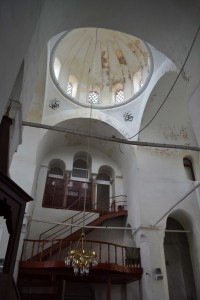
Dome and west side of nave
In summer 2019, a new restoration is in full swing.

Categories: Uncategorized | 1 Comment »
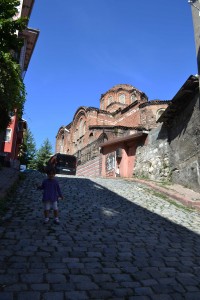
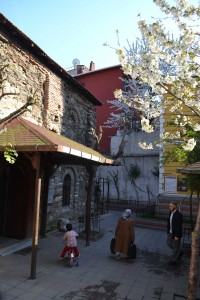
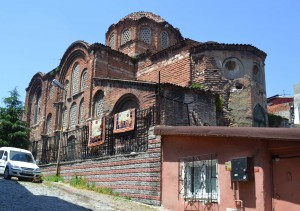
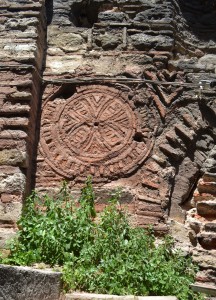
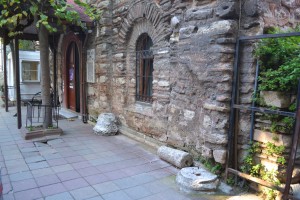
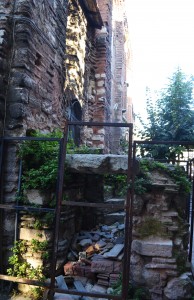
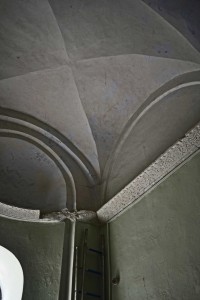
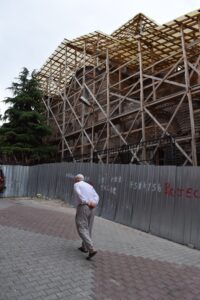

November 26th, 2014 at 5:37 am
[…] used contemporary accounts to place the Monastery of Christos Pantepoptes on the site of the Eski Imaret Camii in the Zeyrek area. Pantepoptes means ‘the all-seeing’, an appropriate name for a place […]